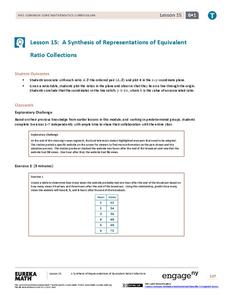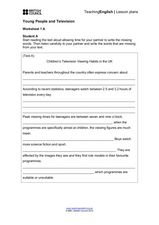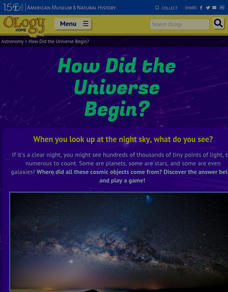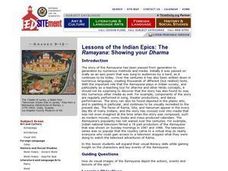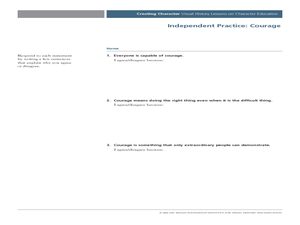EngageNY
A Synthesis of Representations of Equivalent Ratio Collections
Make all the ratio representations fit together. The 15th segment in a series of 29 presents ratio problems to solve. Scholars use a variety of representations to respond to the questions. The problem set has pupils show how the...
Curated OER
"Television"
In this reading comprehension instructional activity, learners read a text about the beginnings of television. Students answer 10 multiple choice questions.
Media Smarts
Looking at Food Advertising
Tony The Tiger, The HoneyComb Kid, The Nestle Quick Bunny. As part of a study of the methods advertisers use to sell foods and how this advertising effects their food choices, kids create their own spokescharacter and/or jingle for...
Curated OER
Science TV: Making it Real
Students explore the ways science is presented in a children's television show. Students conduct internet research, and then create and design a skit that highlights the problem-solving process.
Curated OER
Survivor: Not Just a TV Show -- An exploration of the character traits of survivors of the teenage years
Learners examine the issues that many male and female teenagers are forced to deal with during their adolescence. They analyze characters from different genres through comparing and contrasting their stories and the skills they used to...
Curated OER
Panther Prime Time Morning News Show
Students write, direct, produce and star in a morning news show to be aired live to the student body three days a week. Fourth graders are the show's anchors amd fifth graders man the production equipment.
Perkins School for the Blind
The Germinator
How does a plant grow from a seed? Observe the process with a clever idea from the PBS television show ZOOM. Watch the video, then have your young botanists create their own germinators. The instructional activity described here is for...
Curated OER
Show Me the Story
Young scholars examine the elements of a story, read a review of Chris Rock's new sitcom, "Everybody Hates Chris" and create original sitcom episodes based on their own lives.
Curated OER
Putting on a Show
Students list and research "cutting edge" technology, then develop a Consumer Electronics Trade Show by designing posters, and developing speeches to promote products.
Curated OER
Television: Comedy Vs. Drama
Students investigate the world of Television by contrasting specific programs. In this visual storytelling lesson, students compare and contrast the differences between comedy and drama by making a Venn Diagram. Students...
American Museum of Natural History
How Did the Universe Begin?
The Big Bang Theory is more than a television show. Pupils read how Edwin Hubble observed other galaxies and noticed that the galaxies are moving away from each other. Scholars learn about the idea of the big bang and what happened next...
Curated OER
Writing a TV Advertisement
Students create their own advertisement for their favorite TV show. In this illustrating lesson, students write a paragraph about their favorite TV show then create and advertisement for it. Students then share with the class.
Curated OER
Irregularly Scheduled Programming
Learners examine their favorite holidays and how they are celebrated. After reading an article, they discuss the length of television programming for the Super Bowl. In groups, they create their own television programming relating to...
Curated OER
The Ramayana: Showing your Dharma
Students identify characters and events from the Ramayana. They discuss ways in whcih the images convey non-verbal information and messages. They discuss similarities and differences in the visual and verbal tellings of the Ramayana.
Museum of the Moving Image
AdMaker, Nixon vs. Humphrey, “Convention” (1968)
After viewing the infamous 1968 Presidential campaign ad, "Convention," groups use AdMaker to create their own 30 second ad that features Richard Nixon rather than Hubert Humphrey.
Curated OER
The Price Is Right - TV Game Show
Learners play variation of TV game show "The Price is Right" to identify coins and their values.
Curated OER
Estimation and Your TV Diet
Students develop estimation skills by using real life situations. In this estimation lesson students collect data about their television watching habits. They make hypothesis about the number of hours they watch, how many...
Curated OER
Media Arts: Creating Great Audio for Video
Students learn the basic concepts necessary to produce broadcast quality audio recordings of human speech, which can then be used in professional radio or television productions.
Curated OER
Create a Country
Young scholars work in small groups to list features and elements found on a variety of grade- appropriate maps. They develop a class list of map features and elements to draw from as they create a map of an imaginary country.
Curated OER
Create a Weather Newscast
Fourth graders explore and study basic weather terms, strengthen research skill on the web and create a weather newscast. They choose a weather site on the web, copy weather maps and create a videotape based on a written script to...
Curated OER
Creating Character: Courage
Students explore the concept of courage, both in themselves and in others. In this history and character education lesson, students discuss the characteristics of courage and what it means and how one can show it. Students listen to...
Curated OER
The Lion, the Witch and The Wardrobe: Literature and Theater
Students read and discuss the literary elements of "The Lion, the Witch and the Wardrobe" by C.S. Lewis. They explore the elements of dramatic performance and create a TV news program based on life in Narnia. They videotape their...
DiscoverE
Slender Tower Challenge
Looking for an engineering project that will tower above the rest? Try a design experiment that has built-in fun! Groups examine a variety of skyscraper designs, then compete to create their own slender towers. The teacher's guide is...
CK-12 Foundation
Fitting Lines to Data
Scatter the TV sales over weeks. Pupils create a scatter plot to display the number of TV sales over a period of several weeks. The interactive allows class members to create two lines of best fit. Then they determine which line fits...
